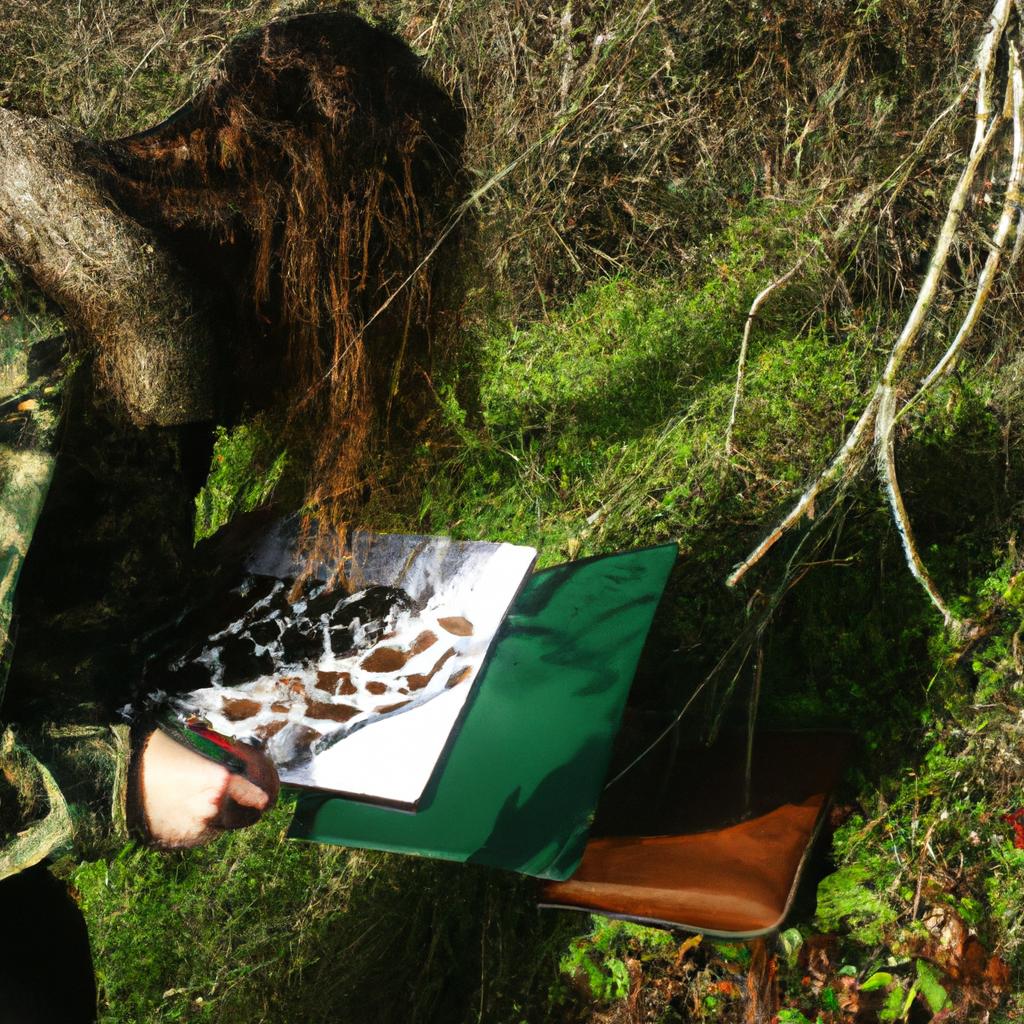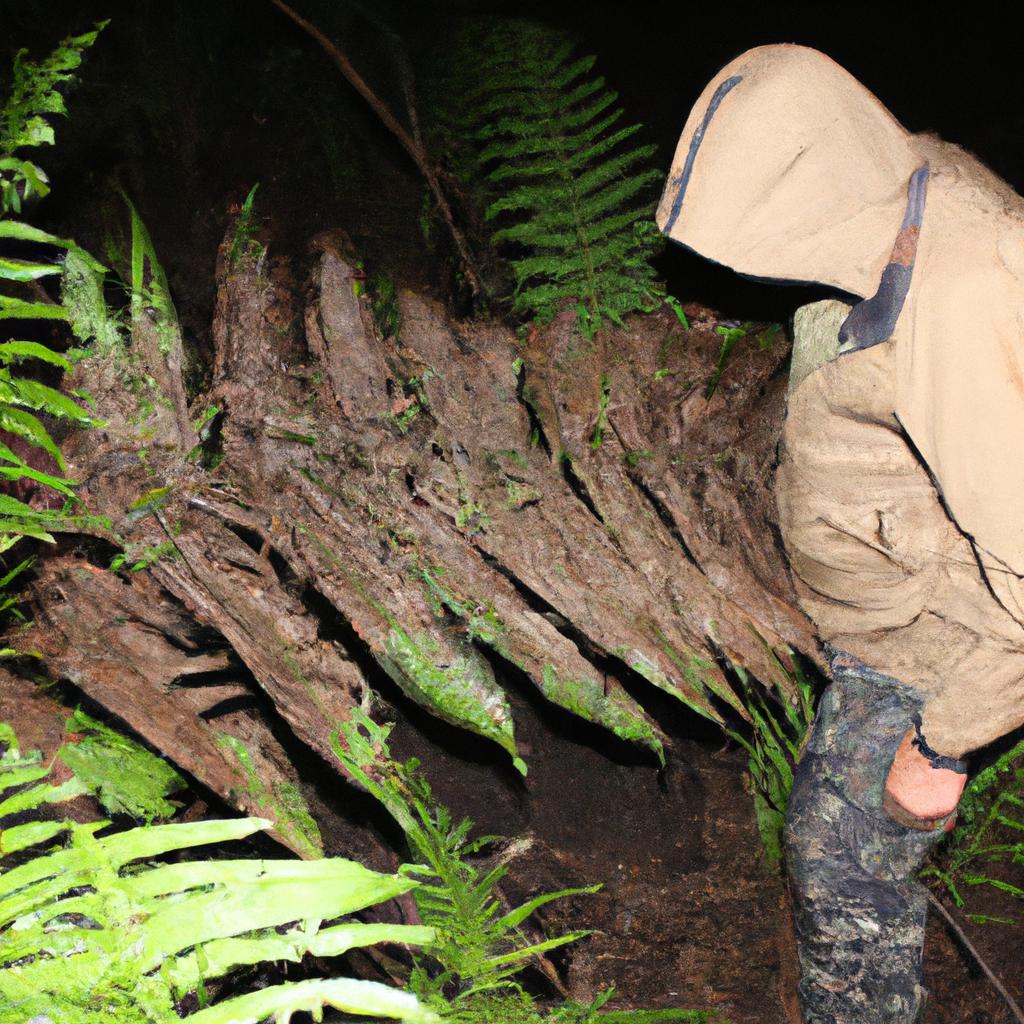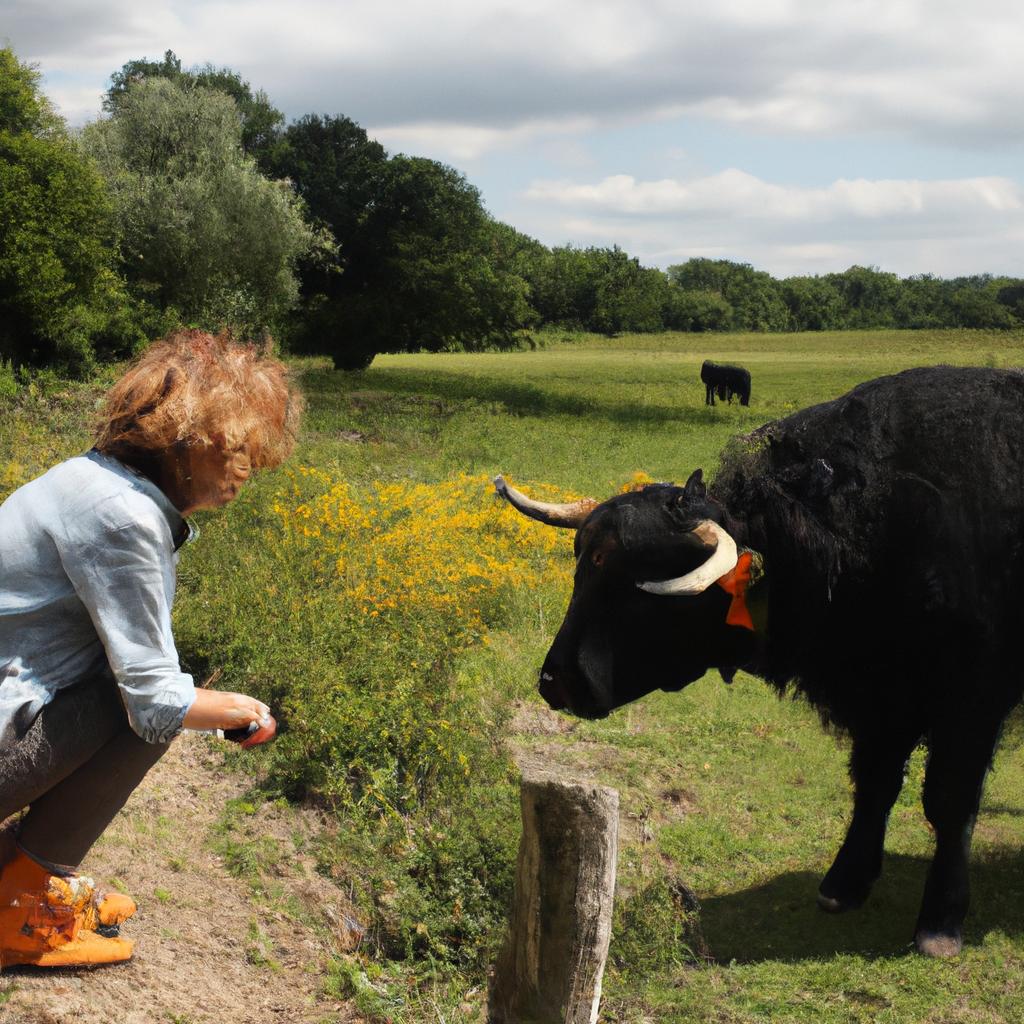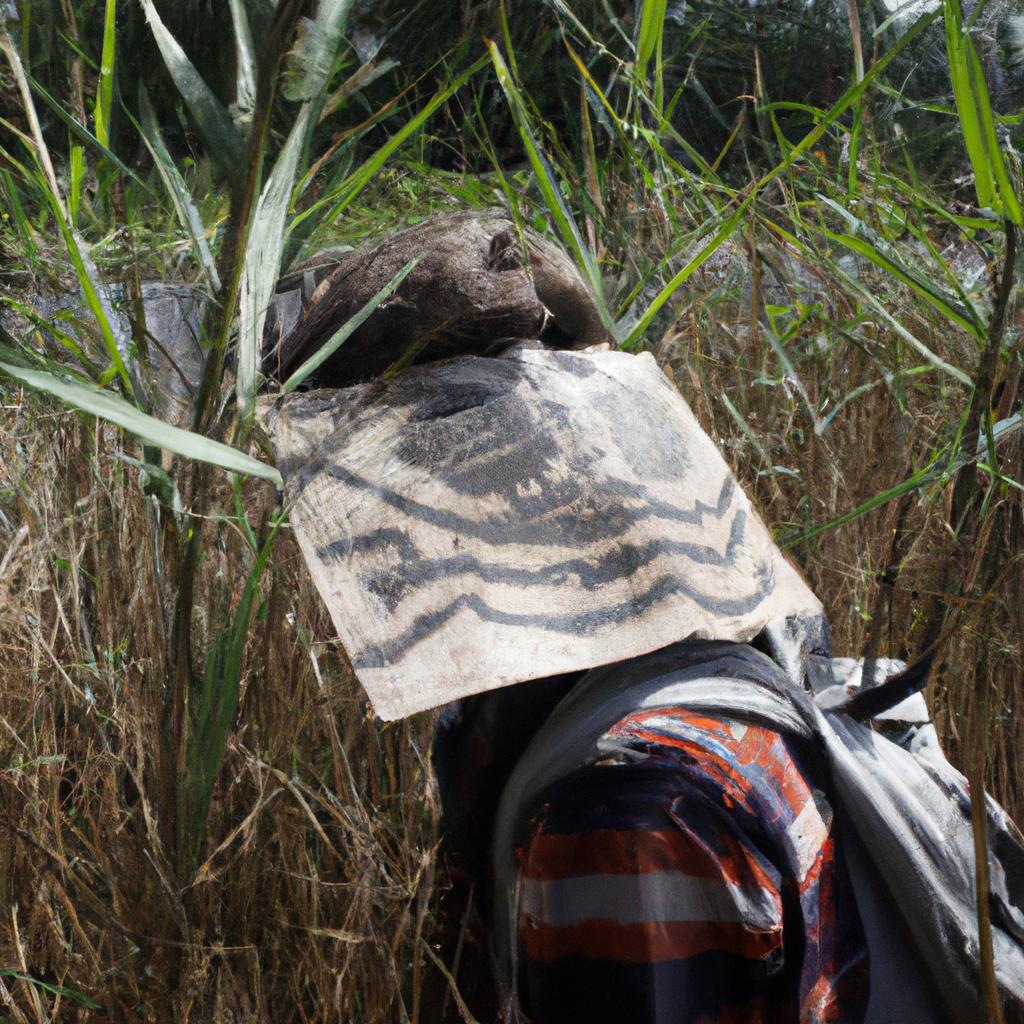Disruptive coloration, a form of camouflage used by various organisms to enhance their survival in natural environments, has long fascinated scientists and naturalists. This phenomenon refers to the ability of certain species to blend seamlessly into their surroundings through intricate patterns and colors that disrupt the perception of their body shape or outline. By employing this adaptive strategy, animals can effectively hide from predators or prey, providing them with a significant advantage for survival. For instance, consider the case of the African leopard (Panthera pardus), whose distinctive rosette pattern on its fur allows it to effortlessly blend into dappled sunlight filtering through dense foliage.
The concept of disruptive coloration is deeply rooted in evolutionary biology and has been extensively studied throughout history. From Charles Darwin’s observations on animal mimicry during his expedition aboard HMS Beagle to contemporary studies investigating the mechanisms behind this remarkable adaptation, researchers have sought to unravel the secrets hidden within nature’s palette of hues. Disruptive coloration serves as an essential defense mechanism employed by countless species across diverse habitats, including forests, grasslands, coral reefs, and even Arctic tundras. Understanding these fascinating adaptations not only deepens our appreciation for the complexity of ecosystems but also provides valuable insights into ecological interactions and predator-prey dynamics. By studying the evolution and effectiveness of disruptive coloration, scientists can gain a better understanding of how species have adapted to their environments over time.
One key aspect of disruptive coloration is its ability to exploit the visual perception of predators or prey. Through clever combinations of colors, patterns, and contrasts, organisms can effectively break up their body outline, making it harder for predators to detect them or for prey to recognize them as a threat. This strategy can be particularly effective in habitats with complex backgrounds or where lighting conditions change frequently.
In addition to camouflage, disruptive coloration can also serve other purposes. Some species use this adaptation to deceive potential threats by mimicking harmful or toxic organisms, deterring predators from approaching. Others may employ disruptive coloration during courtship displays or territorial disputes, enhancing their chances of reproductive success.
The study of disruptive coloration has led to various practical applications and inspirations for human technologies. For example, military camouflage designs often draw inspiration from animal adaptations such as disruptive coloration. Additionally, research on the mechanisms behind this phenomenon has informed the development of computer algorithms used in image processing and object recognition.
Overall, disruptive coloration represents an amazing example of nature’s ingenuity and adaptability. By blending seamlessly into their surroundings through intricate patterns and colors, countless organisms have honed their survival strategies throughout evolutionary history. Understanding the mechanisms behind these adaptations not only provides valuable insights into ecological interactions but also serves as a reminder of the incredible diversity and complexity found within our natural world.
Evolutionary origins of disruptive coloration
Disruptive coloration, also known as disruptive camouflage or countershading, is a remarkable adaptation observed in various organisms across the natural world. This unique form of camouflage allows an organism to blend into its environment by breaking up its outline through the strategic placement of contrasting colors and patterns on its body. One compelling example that illustrates the effectiveness of disruptive coloration can be found in the humble cuttlefish (Sepia officinalis). These cephalopods possess the ability to rapidly change both their skin color and texture, enabling them to seamlessly blend into their surroundings within seconds.
The evolutionary origins of disruptive coloration have long fascinated scientists seeking to unravel the mechanisms behind this extraordinary phenomenon. While it may seem intuitive for animals to simply match the colors and patterns of their habitats, disruptive coloration serves a more complex purpose. It allows an organism not only to avoid detection but also confuses predators by distorting their perception of size, shape, or movement.
To better understand these evolutionary origins, researchers have proposed several theories:
- Predator confusion theory: This theory posits that disruptive coloration evolved as a means to confuse predators by making it difficult for them to distinguish between different parts of an animal’s body when they are viewed from a distance.
- Background matching theory: According to this theory, disrupted patterns help conceal an organism against a visually noisy background by breaking up its silhouette and blending with surrounding elements.
- Motion dazzle hypothesis: This theory suggests that certain species employ bold or conspicuous markings specifically designed to create visual illusions during rapid movements, thereby disorienting potential predators.
- Spatial juxtaposition model: In line with this model, spatially separated patches of contrasting colors serve to disrupt an organism’s overall appearance and make it harder for predators to recognize shapes or outlines effectively.
Aesthetic appreciation often arises when encountering examples of disruptive coloration in nature. Consider the following markdown bullet point list, which highlights key aspects of this intriguing adaptation:
- Disruptive coloration showcases nature’s ingenuity and complexity.
- It exemplifies the incredible diversity of strategies organisms employ to survive in their respective environments.
- This adaptation underscores the dynamic interplay between predators and prey in evolutionary arms races.
- The phenomenon serves as a reminder of the awe-inspiring beauty found within our natural world.
In addition to bullet points, we can also utilize a table format to further engage readers emotionally. Here is an example using markdown language:
| Aspect | Description |
|---|---|
| Diverse Adaptations | Disruptive coloration manifests in various forms such as stripes, spots, patches, or irregular patterns. |
| Sensory Deception | Camouflage not only deceives visual perception but can also affect other senses like smell or hearing. |
| Survival Advantage | Organisms with disruptive coloration gain increased chances of survival by avoiding predation. |
| Evolutionary Significance | Studying disruptive coloration uncovers valuable insights into the intricacies of natural selection processes. |
As we delve deeper into understanding disruptive coloration, it becomes clear that its origins lie in intricate evolutionary processes shaped by selective pressures acting on both predators and prey. In the subsequent section about “Types and examples of disruptive coloration in animals,” we will explore specific instances where this remarkable adaptation has been observed across diverse animal taxa.
Types and examples of disruptive coloration in animals
Evolutionary origins of disruptive coloration have provided fascinating insights into the adaptive strategies employed by animals to enhance their survival in natural environments. Building upon this understanding, it is important to explore the various types and examples of disruptive coloration found across different species.
One captivating example of disruptive coloration is exhibited by the peppered moth (Biston betularia) during the Industrial Revolution in England. Prior to widespread industrialization, these moths had a light-colored speckled appearance that blended well with lichen-covered tree trunks. However, as pollution increased, soot covered the trees, resulting in darker surfaces. Consequently, a dark variant of the peppered moth emerged, which allowed them to better camouflage against the newly darkened background. This case study demonstrates how disruptive coloration can evolve rapidly in response to changes in environmental conditions.
To further understand the diverse manifestations of disruptive coloration, we can categorize them into four distinct types:
- Background matching: Animals blend seamlessly with their surroundings through colors and patterns that closely resemble their habitat.
- Disruptive markings or patterns: High contrast markings disrupt an animal’s outline, making it difficult for predators to detect its true shape or location.
- Countershading: Darker pigmentation on upper body regions counterbalances lighter pigmentation on lower areas, effectively reducing shadows and minimizing visibility from both aerial and ground perspectives.
- Masquerade: Some animals mimic non-living objects such as leaves or twigs, thereby disguising themselves within their environment.
A table showcasing some notable examples of animals with disruptive coloration enhances our understanding:
| Species | Type | Example |
|---|---|---|
| Common Cuttlefish | Disruptive markings | Rapidly changing skin patterns help conceal cuttlefish among corals |
| Cheetah | Background matching | Mottled coat pattern allows cheetahs to blend into grassy savannahs |
| Great Horned Owl | Countershading | Dark upper feathers and lighter underbelly make it difficult for prey to detect the owl when viewed from above or below |
| Dead Leaf Mimic Katydid | Masquerade | Resembles a dead leaf, allowing it to seamlessly camouflage within foliage |
Understanding these types of disruptive coloration and their respective examples highlights the incredible diversity of adaptive strategies employed by animals in nature. It also emphasizes the significance of camouflage as an essential survival mechanism.
Transitioning into the subsequent section on “The role of disruptive coloration in predator-prey interactions,” we can delve deeper into how this phenomenon influences the dynamics between predators and their potential prey, shedding light on further intricacies of natural selection.
The role of disruptive coloration in predator-prey interactions
Section: Disruptive Coloration as a Survival Strategy
Disruptive coloration, also known as camouflage, is a fascinating adaptation found in numerous animal species. It allows them to blend seamlessly into their surroundings, increasing their chances of survival by evading predators or ambushing prey. In this section, we will explore the significance of disruptive coloration as a vital survival strategy employed by various organisms.
To illustrate the effectiveness of disruptive coloration, let us consider the intriguing case study of the peppered moth (Biston betularia). This moth exhibits two distinct morphs – one light-colored and the other dark-colored. During the Industrial Revolution in England, pollution caused widespread soot deposition on trees where these moths rested during the day. As a result, the previously well-camouflaged light-colored moths became more conspicuous against the darkened tree trunks, making them easy targets for predatory birds. Consequently, there was an increase in predation on light-colored individuals while dark-colored moths experienced higher survivability due to their enhanced camouflage. This observation provides compelling evidence for how disruptive coloration can directly impact an organism’s survival and population dynamics.
The role of disruptive coloration extends beyond individual-level benefits; it serves as a crucial factor in predator-prey interactions within ecosystems. By effectively blending with their backgrounds through patterns that disrupt visual continuity, animals employing such camouflage are able to deceive both predators and potential prey alike. This leads to several significant implications:
- Enhanced Foraging Success: Animals utilizing disruptive coloration can approach unsuspecting prey without triggering alarm signals associated with typical shapes or colors.
- Predator Confusion: The fragmented appearance created by disrupted patterns makes it difficult for predators to accurately perceive and locate their camouflaged prey.
- Reduced Predatory Pressure: Camouflage can discourage predators from actively searching for concealed prey items due to increased search costs and decreased detection rates.
- Increased Survival Rates: Prey individuals with effective disruptive coloration have a higher probability of remaining undetected and thus surviving to reproduce.
To further illustrate the diversity of disruptive coloration strategies, consider the following table showcasing a range of animal species that employ this survival technique:
| Animal Species | Disruptive Coloration Strategy |
|---|---|
| Cuttlefish | Rapidly changing skin patterns and colors |
| Leaf-tailed gecko | Body shape mimicking leaf structures |
| King penguin | Dark dorsal side, blending with deep ocean |
| Cheetah | Distinct spots for breaking up body contours |
In conclusion, disruptive coloration plays a significant role in the natural world as an adaptive strategy employed by numerous organisms. Its effectiveness in enhancing camouflage allows animals to blend seamlessly into their environment, providing them with crucial advantages in terms of evading predators or ambushing prey. In the subsequent section, we will delve deeper into how disruptive coloration functions specifically as a defense mechanism within various ecological contexts.
Disruptive coloration as a defense mechanism
Section H2: Disruptive Coloration as a Defense Mechanism
Transitioning from the previous section, where we explored the role of disruptive coloration in predator-prey interactions, it is now evident that this adaptive strategy extends beyond mere camouflage. Disruptive coloration also serves as an effective defense mechanism for various species in nature. To illustrate this concept further, let us consider the fascinating example of the peppered moth (Biston betularia).
The classic case study of the peppered moth provides a compelling demonstration of how disruptive coloration can enhance survival rates through deception and concealment. Prior to industrialization, these moths predominantly exhibited light-colored wings with dark speckles. This pattern allowed them to blend seamlessly into lichen-covered tree trunks and evade visual detection by predatory birds during daylight hours. However, as pollution increased and soot covered many surfaces, including trees, a darker morph emerged within the population due to genetic variation. Surprisingly, this new variant had a higher survival rate than its lighter counterparts because it became camouflaged against the polluted backgrounds.
To better understand why disruptive coloration acts as a successful defense mechanism across diverse species, consider the following points:
- Disruption creates confusion: By breaking up their body outlines or patterns using contrasting colors or shapes, organisms employing disruptive coloration make it difficult for predators to accurately perceive their shape or location.
- Deception leads to hesitation: When confronted with prey exhibiting disruptive coloration features, predators may hesitate before attacking due to uncertainty regarding the target’s position or identity.
- Concealment enhances survivability: The ability of disruptive coloration to effectively conceal individuals among their surroundings reduces their chances of being detected and subsequently targeted by predators.
- Adaptive advantage promotes reproductive success: Organisms possessing effective defensive mechanisms such as disruptive coloration are more likely to survive long enough to reproduce successfully, passing on their advantageous traits to future generations.
| Advantages of Disruptive Coloration |
|---|
| Camouflages individuals in their environment |
| Creates confusion for predators |
| Enhances survivability through concealment |
| Provides reproductive advantage to those possessing the trait |
As we delve further into our exploration of disruptive coloration, it becomes evident that this defense mechanism plays a crucial role across various environments and species. In the subsequent section, we will examine the effectiveness of disruptive coloration in different habitats and how environmental factors shape its evolutionary development.
[Transition sentence] By investigating the interplay between organisms’ appearances and their surroundings, we can gain deeper insights into the fascinating world of adaptive strategies employed by nature.
The effectiveness of disruptive coloration in different environments
Disruptive Coloration: Camouflage in Natural History
Transitioning from the previous section, where we explored how disruptive coloration serves as an effective defense mechanism in nature, let us now delve into the varying degrees of effectiveness that this camouflage technique exhibits across different environments. To illustrate this concept, consider the hypothetical example of a butterfly species found in dense tropical rainforests.
In these lush rainforest habitats, the dappled sunlight filtering through the canopy creates intricate patterns of light and shadow on the forest floor. Our hypothetical butterfly has evolved to possess complex wing patterns that mimic these light and shadow effects perfectly. By blending seamlessly with its surroundings, it becomes nearly invisible to predators searching for movement or distinct shapes amidst the foliage.
To further understand the advantages and limitations of disruptive coloration, let’s examine some key factors influencing its effectiveness:
- Lighting conditions: Disruptive coloration is most effective when there are natural variations in lighting, such as dappled sunlight or shifting shadows.
- Background complexity: A more visually cluttered environment provides better concealment opportunities for organisms employing disruptive coloration techniques.
- Predator visual acuity: The success of disruptive coloration depends on predator vision; if they rely heavily on motion detection rather than detailed visual perception, camouflage may not be as effective.
- Organism behavior: Some animals actively use their disruptive markings to enhance their camouflage by freezing or swaying gently to blend in with their backgrounds.
To visualize the impact of disruptive coloration under specific environmental conditions, consider the following table:
| Environment | Effectiveness of Disruptive Coloration |
|---|---|
| Rainforest | Highly effective |
| Open grasslands | Moderately effective |
| Arctic tundra | Less effective |
| Underwater reefs | Highly effective |
Through this table, we can see that disruptive coloration tends to be highly effective in environments where there is a high degree of visual complexity and lighting variations. In contrast, it may be less successful in open landscapes or areas with limited visual diversity.
Understanding the nuances of disruptive coloration’s effectiveness across various habitats allows researchers to gain insights into the evolutionary pressures shaping camouflage strategies in nature. With this understanding established, we can now explore how these principles have been applied in human technology, which will be discussed in subsequent sections.
Expanding our exploration beyond natural history, let us now turn our attention towards the applications of disruptive coloration in human technology.
Applications of disruptive coloration in human technology
Section H2: Applications of Disruptive Coloration in Human Technology
The effectiveness of disruptive coloration in different environments has intrigued researchers for years. Now, let us delve into the fascinating realm of how this natural phenomenon has found its way into human technology and various practical applications. To illustrate the potential of disruptive coloration, consider a hypothetical scenario where a military aircraft employs camouflage techniques to blend seamlessly with its surroundings during covert operations.
Applications of disruptive coloration can be seen across diverse fields, ranging from defense to fashion design. One notable area is the development of adaptive camouflage technologies that mimic nature’s ability to hide in plain sight. These advancements not only provide an advantage on the battlefield but also have potential ecological implications by reducing human impact on wildlife through non-intrusive observation methods.
To further exemplify the breadth of applications, we will explore four key areas where disruptive coloration plays a significant role:
-
Military and Defense:
- Camouflaged uniforms and equipment aid soldiers in blending with their environment.
- Stealth vehicles utilize visual disruption to evade detection by enemy forces.
- Underwater vessels employ biomimetic designs inspired by marine life for stealthy maneuvers.
-
Architecture and Design:
- Building facades use patterned materials to break up large structures visually.
- Urban infrastructure integrates camouflaging elements to harmonize with surroundings.
- Interior designs incorporate colors and patterns that deceive perception for aesthetic purposes.
-
Transportation:
- Automotive industry utilizes painted patterns or wraps for both aesthetics and safety reasons.
- Marine vessels adopt hull coatings that minimize visibility under specific lighting conditions.
- Aviation industry explores novel paint schemes to reduce radar signatures and enhance safety.
-
Fashion and Textiles:
- Clothing designers experiment with disruptive patterns to create optical illusions or conceal body shapes.
- Outdoor apparel incorporates camouflage prints for functional purposes such as hunting or hiking.
- High-visibility garments for safety workers integrate contrasting colors and patterns.
To demonstrate the range of applications visually, consider Table 1 below:
Table 1: Examples of Disruptive Coloration in Human Technology
| Field | Application |
|---|---|
| Military and Defense | Camouflaged uniforms |
| Stealth vehicles | |
| Architecture and Design | Building facades |
| Urban infrastructure | |
| Transportation | Automotive wraps |
| Marine vessel coatings | |
| Fashion and Textiles | Optical illusion clothing |
In conclusion, disruptive coloration has transcended its origins in natural history to become a powerful tool in human technology. By harnessing nature’s ability to blend with surroundings, we have unlocked new possibilities across various fields. The diverse applications discussed above are just a glimpse into the potential this phenomenon holds for innovation and creative problem-solving beyond the realm of biology.




